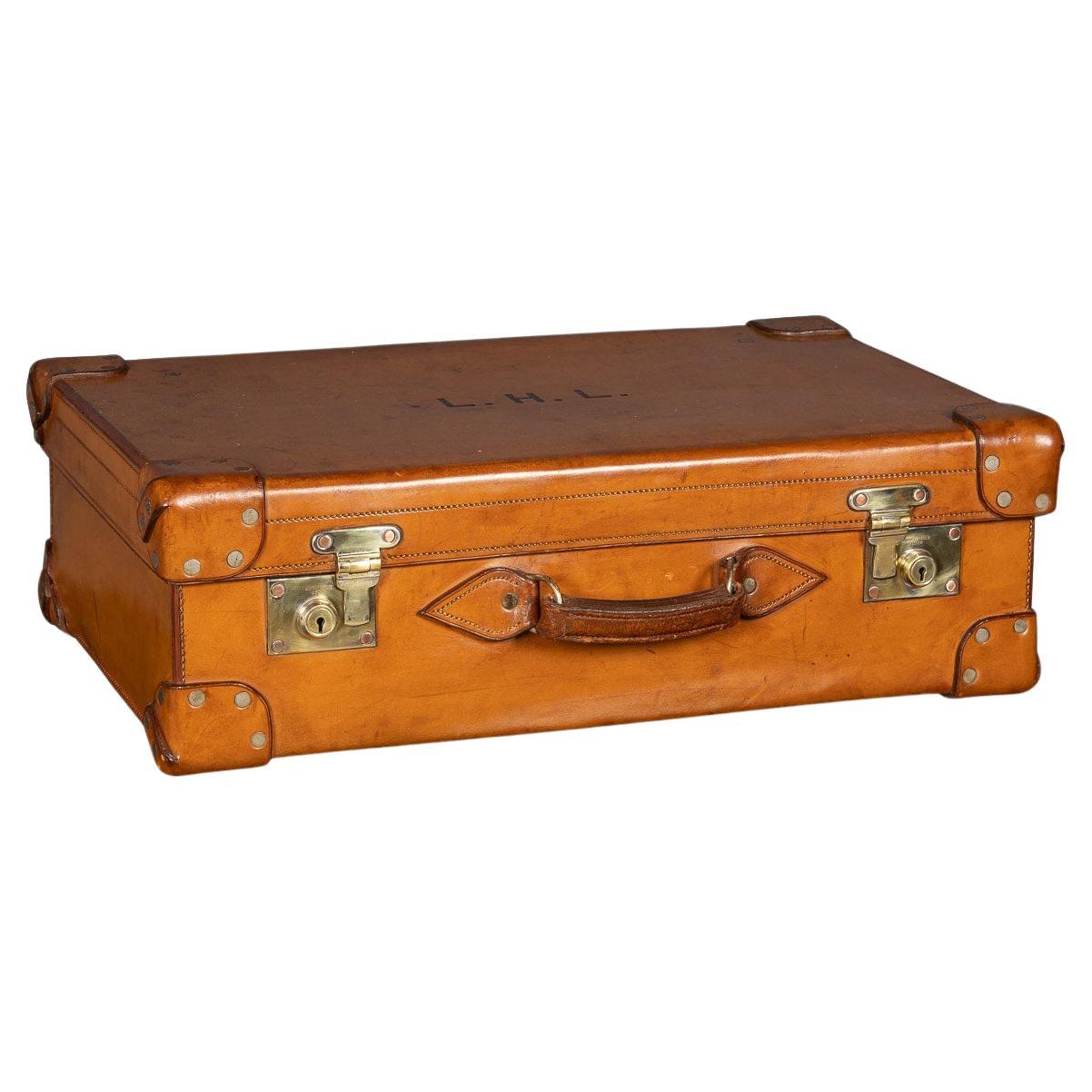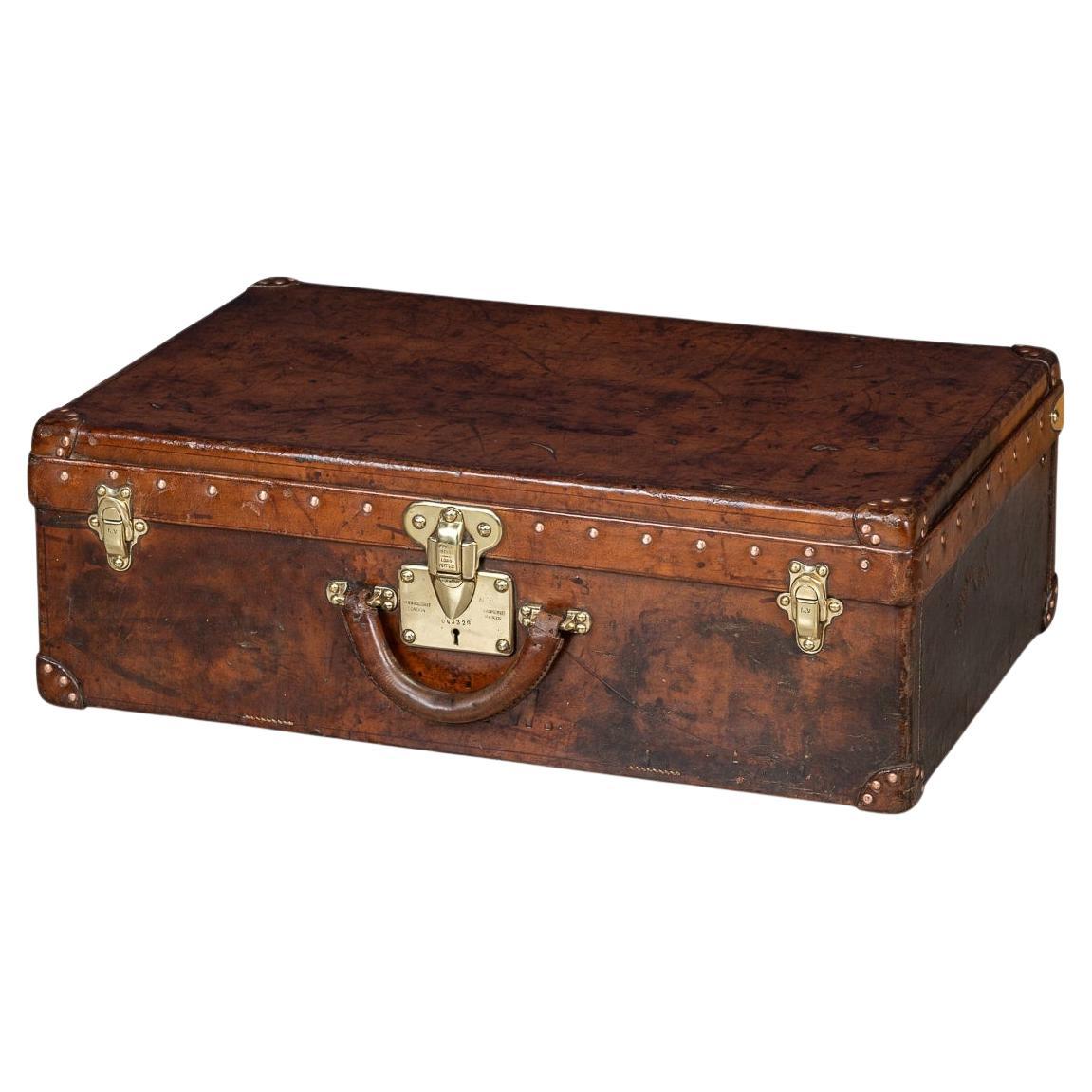Items Similar to 20th Century French Set of Four Suitcases, Leather and Ponyskin
Want more images or videos?
Request additional images or videos from the seller
1 of 6
20th Century French Set of Four Suitcases, Leather and Ponyskin
About the Item
Elegant, quirky, eccentric set of four suitcases, made in France, leather
and ponyskin, initials V.M.L.
Dimensions :
1 x 60 x 40 cm x 17 cm high
1 x 70 x 45 cm x 19 cm high
2 x 80 x 50 cm x 22 cm high.
- Dimensions:Height: 8.67 in (22 cm)Width: 31.5 in (80 cm)Depth: 19.69 in (50 cm)
- Sold As:Set of 4
- Materials and Techniques:
- Place of Origin:
- Period:
- Date of Manufacture:1950s
- Condition:Wear consistent with age and use.
- Seller Location:Brecht, BE
- Reference Number:1stDibs: LU240338079673
About the Seller
4.9
Gold Seller
These expertly vetted sellers are highly rated and consistently exceed customer expectations.
Established in 1994
1stDibs seller since 2016
190 sales on 1stDibs
Typical response time: 9 hours
- ShippingRetrieving quote...Ships From: Brecht, Belgium
- Return PolicyA return for this item may be initiated within 3 days of delivery.
More From This SellerView All
- Early 20th Century Vellum SuitcaseLocated in Brecht, BEcharming suitcase, from the 1920'sCategory
Early 20th Century French Trunks and Luggage
MaterialsLeather
- 20th Century Iron Sculpture of a FishLocated in Brecht, BEGreat patination on this fish sculpture, mounted on iron base, found in Spain.Category
20th Century Spanish Animal Sculptures
MaterialsIron
- 20th Century Plaster FiguresLocated in Brecht, BEThese plaster figures of nose and lips, David by Michelangelo, after the antique, were made in the 1950s by students of an Academy of Arts in Paris.Category
Vintage 1950s French Figurative Sculptures
MaterialsStone
- 20th century publicity sign ...Located in Brecht, BEa publicity sign for sneakers "Vans" ... fun object ...Category
Late 20th Century French Toys
MaterialsResin
- 20th Century Floorlamp by Chan Chen, French ArtistLocated in Brecht, BEFrench artist Chan Chen made this lamp for a house in Nice, South of France, during the 1990's, a unique piece.Category
20th Century French Floor Lamps
MaterialsIron
- Mid 20th Century Moroccan RugLocated in Brecht, BEA Moroccon rug, rare to find these in this xl size, 440 x 280 cm.Category
Mid-20th Century Moroccan Moroccan and North African Rugs
MaterialsWool
You May Also Like
- 20th Century Revelation Expanding Leather Suitcase, c.1920Located in Royal Tunbridge Wells, KentAntique early 20th Century Bridle Hide Revelation expanding leather suitcase, a hallmark of innovation from the 1920's, showcased a pioneering design that allowed for adjustable stor...Category
20th Century British Trunks and Luggage
MaterialsBrass
- 20th Century British Made Bridle Leather Suitcase, c.1910Located in Royal Tunbridge Wells, KentAntique early 20th Century British made Bridle hide covered suitcase. The leather shows wear but is still supple, mounted with brass fittings, oozing charm and elegance. A truly grea...Category
20th Century British Trunks and Luggage
MaterialsLeather
- 20th Century British Made Bridle Leather Suitcase, c.1910Located in Royal Tunbridge Wells, KentAntique early 20th Century British made Bridle hide covered suitcase. The leather shows wear but is still supple, mounted with brass fittings, oozing charm and elegance. A truly grea...Category
20th Century British Trunks and Luggage
MaterialsLeather
- 20th Century Louis Vuitton Cow Hide Suitcase, France c.1920By Louis VuittonLocated in Royal Tunbridge Wells, KentA highly unusual and exceptionally rare Louis Vuitton suitcase, originating from the early years of the 20th century, distinguishes itself not with the globally renowned monogram canvas but with a distinctive covering crafted from a singular piece of cowhide. This unique piece represents a special order from Louis Vuitton, showcasing the brand's historical commitment to utilizing only the finest hides available. Unlike many of its counterparts, leather trunks and cases of this era often struggle to withstand the test of time, requiring regular treatments to prevent drying and disintegration. Remarkably, this particular example defies the odds, retaining the same supple quality it possessed on the day it first graced the shop floor. This suitcase belongs to Louis Vuitton's collection of "speciality materials," which encompasses a diverse range, including, but not limited to, zinc, copper, crocodile leather, and cow leather. A brief history about Louis Vuitton trunks: Louis Vuitton was born in 1821 to a farmer and milliner and came from a long-established working-class family in eastern France. Vuitton grew up understanding the effects of perseverance and a strong work ethic from watching his family. At the age of 16, he made the decision to walk 292 miles from his hometown to Paris to try and make a new life for himself. When he arrived the city was in the midst of industrialization with current modes of transportation evolving quickly allowing for longer journeys. With this came the need for sturdy travel pieces. Vuitton was taken as an apprentice for a successful box maker and packer named Monsieur Marechal. He learned to craft durable containers and how to pack them properly – a well-respected profession at the time.In 1854, years after he had mastered his craft and became well respected for it, Vuitton ventured out on his own to open a shop on Rue Neuve des Capucines. It was here that he began to establish himself as a luggage maker. Then, in 1858, Vuitton designed the first Louis Vuitton steamer trunk. At the time trunks had rounded tops to allow for water to run off but this did not allow for convenient stowage. Vuitton introduced a flat, yet waterproof, trunk that was easily stackable. The first of his trunks were outfitted with a grey canvas referred to as Trianon – it wouldn’t be until several decades later that the signature monogram would be introduced. With a burgeoning business, Vuitton moved his family and workplace to Asniere, where he employed twenty workers to craft his trunks. By 1900 he would have 100 employees, and in 1914 the company would more than double in size. After years of success, Vuitton began to experiment with the design of his luggage by introducing a new striped canvas pattern (1876) and later the still well-known Damier print (1888). The hand-painted patterns were developed to prevent counterfeits. Even in the late 1800s, Louis Vuitton was enough of a status symbol to warrant counterfeiting. In 1886, his son George invented and patented an ingenious locking system that made it impossible to pick the lock of their trunks. This lock is still used today. 1892 would prove to be a time of mourning for the family as Louis Vuitton passed...Category
20th Century French Other Trunks and Luggage
MaterialsBrass
- 20th Century Louis Vuitton Cow Hide Suitcase, France c.1920By Louis VuittonLocated in Royal Tunbridge Wells, KentA highly unusual and exceptionally rare Louis Vuitton suitcase, originating from the early years of the 20th century, distinguishes itself not with the globally renowned monogram canvas but with a distinctive covering crafted from a singular piece of cowhide. This unique piece represents a special order from Louis Vuitton, showcasing the brand's historical commitment to utilizing only the finest hides available. Unlike many of its counterparts, leather trunks and cases of this era often struggle to withstand the test of time, requiring regular treatments to prevent drying and disintegration. Remarkably, this particular example defies the odds, retaining the same supple quality it possessed on the day it first graced the shop floor. This suitcase belongs to Louis Vuitton's collection of "speciality materials," which encompasses a diverse range, including, but not limited to, zinc, copper, crocodile leather, and cow leather. A brief history about Louis Vuitton trunks: Louis Vuitton was born in 1821 to a farmer and milliner and came from a long-established working-class family in eastern France. Vuitton grew up understanding the effects of perseverance and a strong work ethic from watching his family. At the age of 16, he made the decision to walk 292 miles from his hometown to Paris to try and make a new life for himself. When he arrived the city was in the midst of industrialization with current modes of transportation evolving quickly allowing for longer journeys. With this came the need for sturdy travel pieces. Vuitton was taken as an apprentice for a successful box maker and packer named Monsieur Marechal. He learned to craft durable containers and how to pack them properly – a well-respected profession at the time.In 1854, years after he had mastered his craft and became well respected for it, Vuitton ventured out on his own to open a shop on Rue Neuve des Capucines. It was here that he began to establish himself as a luggage maker. Then, in 1858, Vuitton designed the first Louis Vuitton steamer trunk. At the time trunks had rounded tops to allow for water to run off but this did not allow for convenient stowage. Vuitton introduced a flat, yet waterproof, trunk that was easily stackable. The first of his trunks were outfitted with a grey canvas referred to as Trianon – it wouldn’t be until several decades later that the signature monogram would be introduced. With a burgeoning business, Vuitton moved his family and workplace to Asniere, where he employed twenty workers to craft his trunks. By 1900 he would have 100 employees, and in 1914 the company would more than double in size. After years of success, Vuitton began to experiment with the design of his luggage by introducing a new striped canvas pattern (1876) and later the still well-known Damier print (1888). The hand-painted patterns were developed to prevent counterfeits. Even in the late 1800s, Louis Vuitton was enough of a status symbol to warrant counterfeiting. In 1886, his son George invented and patented an ingenious locking system that made it impossible to pick the lock of their trunks. This lock is still used today. 1892 would prove to be a time of mourning for the family as Louis Vuitton passed...Category
20th Century French Other Trunks and Luggage
MaterialsBrass
- 20th Century Louis Vuitton Suitcase In Monogram Canvas, France c.1970By Louis VuittonLocated in Royal Tunbridge Wells, KentA delightful mid to late 20th-century Louis Vuitton hard-sided case, covered with the iconic monogram canvas and complemented by brass fittings. The exterior exudes the unmistakable ...Category
Vintage 1970s French Other Trunks and Luggage
MaterialsLeather, Canvas
Recently Viewed
View AllMore Ways To Browse
L V Luggage
L V Suitcase
Vintage Leather Suitcase 1950s
Vulcanized Trunk
Antique Footlocker
Antique Picnic Hampers
Antique Yellow Painted Cottage Primitive Folk Art
Black Suede Pocketbooks
Brown Alligator Travel Trunk
Giant Hermes Bag
Goyard Hat Trunk
Goyard Hat
Haskell Trunk
Hermes Steamer Trunk
Large Leather Gladstone Bag
Louis Vuitton Car Trunk
Louis Vuitton Carrier
Louis Vuitton Orange Hat





